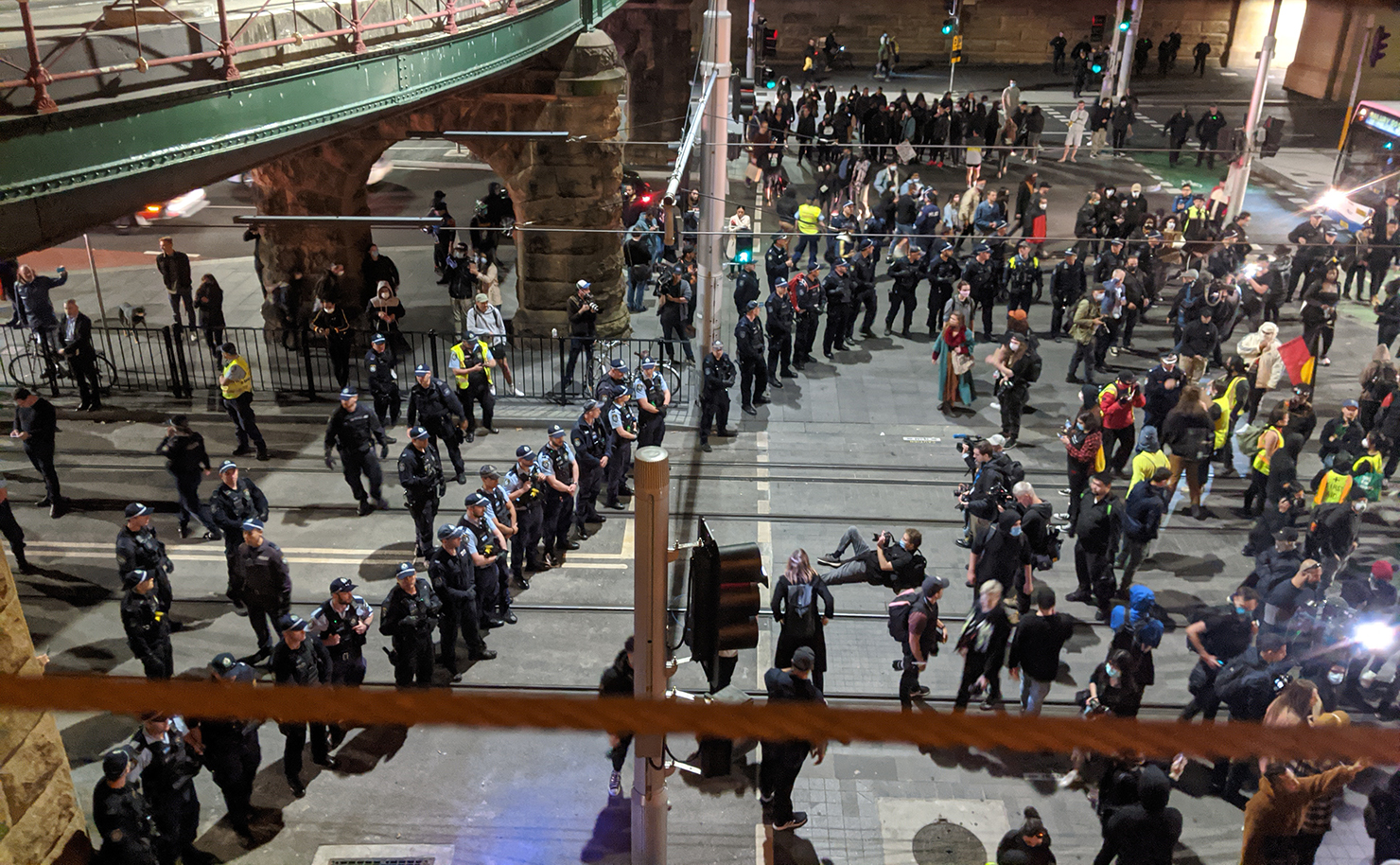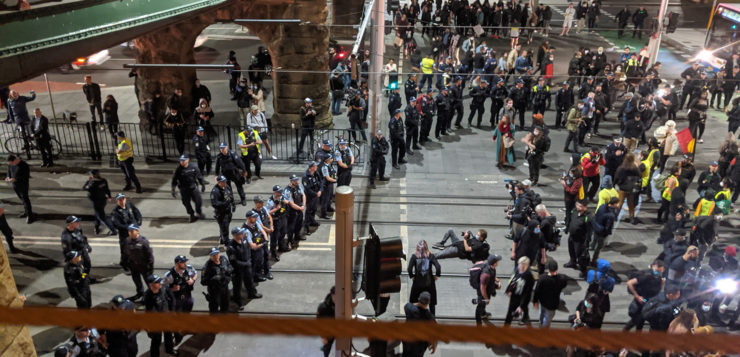DON’T MISS ANYTHING! ONE CLICK TO GET NEW MATILDA DELIVERED DIRECT TO YOUR INBOX, FREE!
After losing a court action to halt a large-scale civil protest that was in large part protesting their entrenched violent behaviour, NSW Police managed to ‘square things up’ at the end of the weekend’s Black Lives Matter protest in Sydney by using a military-style technique which increases the risk of violence, and criminalises the right of ordinary citizens to peacefully protest. Alec Brodie explains.
After citizens were granted permission to exercise their right to peacefully assemble by the NSW Court of Appeal on 6 June 2020, thousands stood in solidarity with First Nations Peoples and the ‘Black Lives Matter’ movement by protesting in and around Town Hall in Sydney, New South Wales.
The NSW Police maintained a peaceful presence throughout the afternoon, working with Indigenous organisers to facilitate road closures. However, the police would later use a punitive yet ‘lawful’ crowd control technique called kettling (Austin & Ors v United Kingdom [2012]), raising grave concerns around the role of police in criminalising citizens’ democratic right to peaceful assembly.
‘Kettling’ is a crowd control tactic that involves the formation of large cordons of police officers to surround a group: the opposite of social distancing. In theory by ‘containing’ disorderly groups the police are more effectively able to maintain public safety.
In a coordinated effort, the Mounted Police Unit and multiple lines of Public Order & Riot Squad (PORS) police ‘kettled’ demonstrators and members of the public from Eddy Avenue into the narrow lower concourse of central station. In doing so, the police manufactured a dangerous situation that escalated tensions, compromising the safety of police officers and members of the public.
While there is some evidence that kettling may help contain public disorder, other studies show that trapping demonstrators within a kettle is one of many oppressive tactics that escalates rather than prevents conflict with law enforcement.
On the public record, acting NSW Police Commissioner Mal Lanyon defended the tactics used at Central Station, stating that “Police attempted to quell the situation”. Kettling has long been used by the NSW Police to disrupt protests. For demonstrators, however, being ‘kettled’ represents an intimidating tactic focussed on deterring them from exercising their democratic right to protest in public spaces.
Once the NSW Police had encircled the crowd, protestors were brutally pushed back each time the police advanced their line. Eventually the Police forced hundreds inside the confined station, disregarding the public safety risk posed by trapping protestors against one another. Without warning, police also pepper sprayed numerous demonstrators — including but not limited to a young woman with a physical impairment and minors — before issuing a formal move-on order over a loudspeaker.
The effects of the chemical irritant were exacerbated by the confined space and limited ventilation inside the train station. The authorisation to use pepper spray to ‘disperse the crowd’ seemed misguided and inconsistent with the fact that protesters were kettled by a police line blocking off the exit to the train station.
Policing scholar Andrew Neal and colleague’s claim that unlike traditional policing techniques of crowd dispersal, the kettle detains protestors in order to “exhaust their political energies”. The confinement of demonstrators in the police cordon within the underground section of Central Station was consistent with these aims. It was deeply frightening and created a suffocating atmosphere.

The rapid and military-like response by the NSW Police in detaining protestors within a cordon raises concerns about the ethical and political significance of this strategy. Whilst ‘kettling’ is a recent phenomenon in policing, its principals to enclose and isolate the ‘enemy’ are based upon pre-established techniques used in military contexts.
Unlike traditional public order strategies of crowd dispersal, kettling represents a new political tactic through which to stifle demonstrations that threaten the productive circulation of traffic and pedestrian movement. In this sense Andrew Neal states the “territorialising act” of kettling aims to protect the urban flows of people and traffic outside the police line.
Whilst protecting the productive movements of the city, the kettle stifles public dissent, neutralising the political movement through physical containment. The kettle is perhaps the most symbolic form of exclusionary policing whereby lines of police and elements of the built environment act as territorial boundaries.
Penning the crowd into the tightly confined space of the Central concourse was part of a coordinated effort by NSW Police to reduce the ‘Black Lives Matter’ movement to what Neal et al. (2019) describes as “uncivil noise”. It allowed the police to manufacture a situation that required the use of more coercive and equally harmful means — including but not limited to the dispersion of pepper spray.
Kettling is an established — and coercive — public order response to political assembly in Western police forces. It is one of many reasons why citizens should continue to question the use of police powers to criminalise peaceful assembly, particularly in relation to the stifling of First Nations voices.
If you have been stopped by police or have had any interaction with the police since the new public health directions (or know of an incident that concerns you) please report it here.
BE PART OF THE SOLUTION: WE NEED YOUR HELP TO KEEP NEW MATILDA ALIVE. Click here to chip in through Paypal, or you can click here to access our GoFundMe campaign.
Donate To New Matilda
New Matilda is a small, independent media outlet. We survive through reader contributions, and never losing a lawsuit. If you got something from this article, giving something back helps us to continue speaking truth to power. Every little bit counts.




